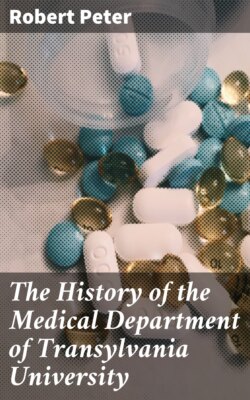Читать книгу The History of the Medical Department of Transylvania University - Robert Drummond Peter - Страница 10
На сайте Литреса книга снята с продажи.
Doctor Samuel Brown,
ОглавлениеThe first Medical Professor of Transylvania University and of the great Western country, was born in Augusta, or Rockbridge County, Virginia, January 30, 1769, and died near Huntsville, Alabama, at the residence of Colonel Thomas G. Percy, January 12, 1830. He was the son of Reverend John Brown, a Presbyterian minister of great learning and piety, and Margaret Preston—a woman of remarkable energy of character and vigor of mind—second daughter of John Preston and Elizabeth Patton.[7] He was the third of four distinguished brothers—Honorable John Brown, Honorable James Brown, Doctor Samuel Brown, and Doctor Preston Brown.
After graduating at Carlisle College, Pennsylvania, where he had been sent by his elder brother, he studied medicine for two years in Edinburgh, Scotland. Doctor Hosack, of New York, and Doctor E. McDowell, of Danville, Kentucky, were of the same class. Returning to the United States, he commenced practice in Bladensburg, but soon removed to Lexington, Kentucky, where he was made Professor of Chemistry, Anatomy, and Surgery in Transylvania University in 1799, as above stated. In 1806, he removed to Fort Adams, Mississippi, where he married Miss Percy, of Alabama.[8] Afterward returning to Lexington he was re-appointed in 1819 to a chair in the Medical Department of Transylvania, that of Theory and Practice. Here he was a distinguished colleague of Professors B. W. Dudley, Charles Caldwell, Daniel Drake, William Richardson, and James Blythe until 1825, when he finally left Kentucky.
Doctor Brown was a man of fine personal appearance and manners; an accomplished scholar, gifted with a natural eloquence and humor that made him one of the most fascinating lecturers of his day. Learned in many branches, he was an enthusiast in his own profession, scrupulous in regard to etiquette and exceedingly benevolent and liberal of his time and services to the poor. Although active in scientific pursuits he left no extensive work, and but a few detached writings to perpetuate his fame.
DOCTOR SAMUEL BROWN.
From Jouett's Portrait at Frankfort.
His name appears among those of the contributors to the American Philosophical Transactions, and to the medical and scientific periodicals of the day, both in this country and in Europe. In those Transactions and in Bruce's Journal of Mineralogy, etc., he described a remarkably large nitre cavern on Crooked Creek in Madison County (now Rockcastle County), Kentucky. In this and in a subsequent communication in Volume I of Silliman's Journal he described the process of nitre manufacture in caves, and gave the best theory of its formation, according to the science of the day. In various other journals he described several interesting cases which occurred in his own practice, and in the renowned Medical Logic, by the distinguished Gilbert Blane, of London, Doctor Samuel Brown, of Lexington, is quoted as authority for a certain scientific fact. "To him we are indebted for the first introduction in the West of the prophylactic use of the cow-pox. As early as 1802 he had vaccinated upwards of five hundred persons, when in New York and Philadelphia physicians were only just making their first experimental attempts. The virus he used was taken from its original source, the teats of the cow, and used in Lexington even before Jenner could gain the confidence of the people of his own country."[9]
A curious anecdote, illustrating progress, was told of Doctor Samuel Brown by his nephew, the late Orlando Brown, Esquire, of Frankfort, in a letter to the present writer:
"I remember once when talking of calomel, he said he never would forget the first dose of it he gave a patient. It was looked upon as 'the Hercules,' and he used it accordingly. The case was desperate and he resolved to venture upon calomel and give a strong dose. He accordingly weighed out with scrupulous accuracy four grains—gave it to his patient, and sat up all night to watch its effects. The man got well and the Doctor afterwards used calomel more freely."
What would he have thought of the heaping tablespoonful doses—quickly repeated pro re nata—or the pound of calomel taken in a day—and survived—which characterized the cholera treatment of one of the later Professors of Transylvania Medical School?
